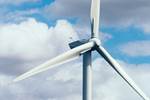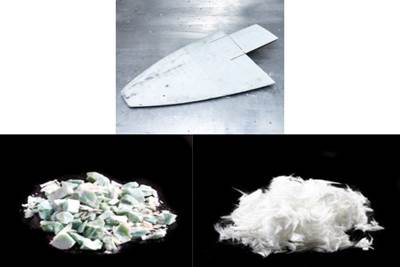U.K. launches initiative for recyclable wind turbine blade technologies
The SusWIND initiative, addressing the recyclability and future development of composite wind turbine blades, will be delivered in three developments.

The U.K.’s National Composites Centre (NCC, Bristol, U.K.) launched SusWIND on Nov. 11, an initiative to accelerate the development of technology, processes and materials that address the recyclability and future development of composite wind turbine blades.
Delivered in partnership with the Offshore Renewable Energy (ORE) Catapult and supported by The Crown Estate and RenewableUK, SusWIND is said to be helping to drive the future sustainability of wind turbine technology, bringing together leading stakeholders in the composites industry and energy sector to solve the following sustainability challenges:
- Recycle: Demonstrating viable technologies for recycling the existing stock of wind turbine blades, many of which are reaching the end of their life, and then using the waste materials to develop secondary applications such as composite parts in electric vehicles, bridges and even in thermal insulation.
- Sustain: Driving the use of more sustainable materials, such as bio-derived feedstock or thermoplastics in developing composites for turbine blades, rather than from unsustainable sources or with limited potential for economic recyclability.
- Design: Developing innovative new approaches based on design for disassembly, using sustainable materials and with end-of-life (EoL) strategies in mind, therefore future-proofing the next generation of wind turbine blades.
NCC states that wind energy is one of the fastest growing sources of renewable energy with predicted global capacity expected to reach approximately 5,000 gigawatts (GW) for onshore and 1,400 GW of offshore capacity by 2050. The U.K. claims to have the the largest offshore wind capacity in the world, with more than 14 GW of total capacity, and is currently on track to exceed 40 GW in the pipeline by 2030, driving toward the country’s commitment to be net zero by 2050.
The initiative will be delivered in three waves of activities to address the sustainability challenges for wind turbine blades.
Technology in turbine blade design and manufacture has also advanced rapidly over the last 40 years. Today, approximately 2.5 million tonnes of composite materials are in use in the wind sector globally, particularly for wind blades. However, although most of the existing components and materials used in wind farms are recoverable and recyclable, the blades are a bigger challenge. According to NCC, around 14,000 wind turbine blades are reaching the end of their usable life and facing either disposal in landfill or incineration.
“Composites are a key enabler for the success of wind energy and the role that it plays in delivering a low carbon global economy. But it is apparent to engineers, economists and environmentalists alike that we need to find a more sustainable way forward,” says Richard Oldfield, chief executive of the NCC. “We must commit to transforming the current linear blade product lifecycle into an increasing circular process that forms part of a larger future market for low carbon, recycled composites materials. Investing now in the future of blade sustainability will help unlock the use of recycled composites for the next generation of sustainable transportation and infrastructure. We’re excited to work with key partners and the wind industry through this ambitious program to deliver a more sustainable future.”
Ambitious leasing rounds are planned for the UK by The Crown Estate which, together with the UK Government and the wind energy sector, has driven the U.K.’s offshore wind capacity from a standing start in 2000 to meeting 10% of the U.K.’s electricity demand by the end of 2020. However, sustainability and technology transcend borders and sectors. The outcomes of SusWIND are designed to support the global challenge for both onshore and offshore wind, reflecting the global footprint of many of the leading organizations in the industry.
SusWIND is being delivered as part of Sustainable Composites, which is looking at the whole lifecycle of composites to future-proof the airplanes, cars and turbines of tomorrow. Led by the NCC and CPI — said to be two of the seven High Value Manufacturing Catapult centers — Sustainable Composites is a partnership between industry, academia and government that will reportedly harness the U.K.’s composites research and technology development capabilities to capitalize on this rapidly growing circa £2 billion global market for EoL recycling.
The initiative will be delivered in three waves of activities to address the sustainability challenges for wind turbine blades:
- Wave 1 will stimulate the supply chain for blade recycling and how it leverages the broader supply chain for composites recycling demand with other sectors. Work packages including landscape mapping, exploitation routes for upscaling viable technologies and demonstrating the effective use of recycled materials in value-add products for other applications.
- Wave 2 will demonstrate options to reduce the environmental footprint of blade manufacture through the use of more sustainable and lower impact material feedstock, and through minimizing or recycling waste streams.
- Wave 3 will develop robust guidelines to improve design for EoL, ensuring waste is minimized and that composite components can be disassembled for cost effective repaired, re-used, remanufactured and recycled more efficiently and cost effectively.
The NCC is looking for more companies from the energy industry to get involved in this program to help to shape the direction of this work. Email suswind@nccuk.com to find out how you can join the consortium.
Related Content
Recycling end-of-life composite parts: New methods, markets
From infrastructure solutions to consumer products, Polish recycler Anmet and Netherlands-based researchers are developing new methods for repurposing wind turbine blades and other composite parts.
Read MorePlant tour: ÉireComposites, Galway, Ireland
An in-house testing business and R&D focus has led to innovative materials use and projects in a range of markets, from civil aerospace to renewable energy to marine.
Read MoreMoving toward next-generation wind blade recycling
Suppliers, fabricators and OEMs across the composite wind blade supply chain ramp up existing technologies, develop better reclamation methods and design more recyclable wind blades.
Read MoreJEC World 2022, Part 1: Highlights in sustainable, digital, industrialized composites
JEC World 2022 offered numerous new developments in composites materials, processes and applications, according to CW senior editor, Ginger Gardiner, most targeting improved sustainability for wider applications.
Read MoreRead Next
Arkema wins Pierre Potier Prize for Elium thermoplastic resin
Following a depolymerization, purification and reformulation process, the resulting Elium thermoplastic resin is said to enable the manufacture of 100% recyclable wind turbine blades.
Read MoreUT receives funding for wind turbine blades recycling technology
The university is developing a large-scale glass fiber composite recycling system as an end-of-life (EoL) solution for wind blades.
Read MoreCW’s 2024 Top Shops survey offers new approach to benchmarking
Respondents that complete the survey by April 30, 2024, have the chance to be recognized as an honoree.
Read More

























